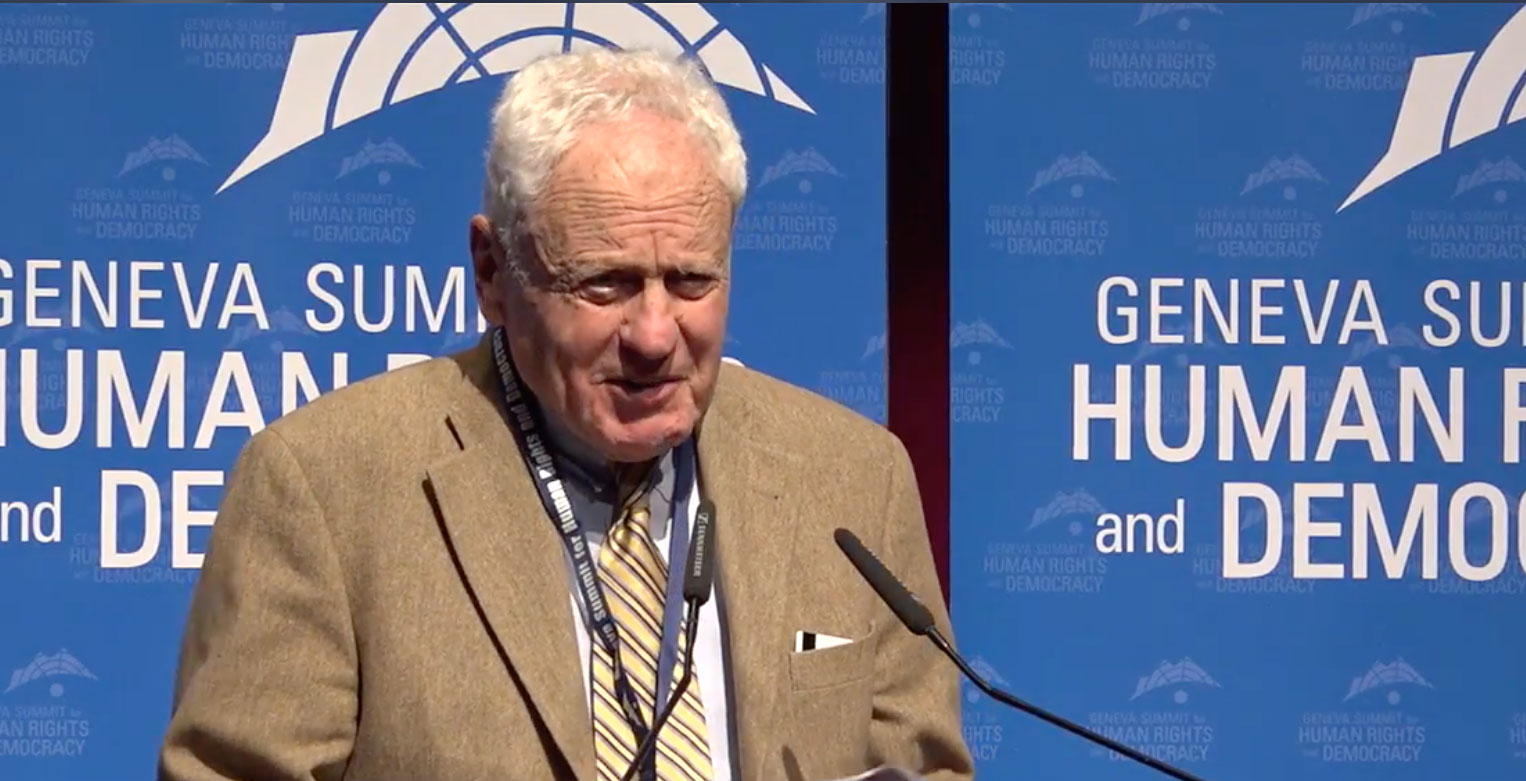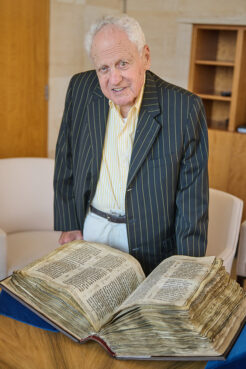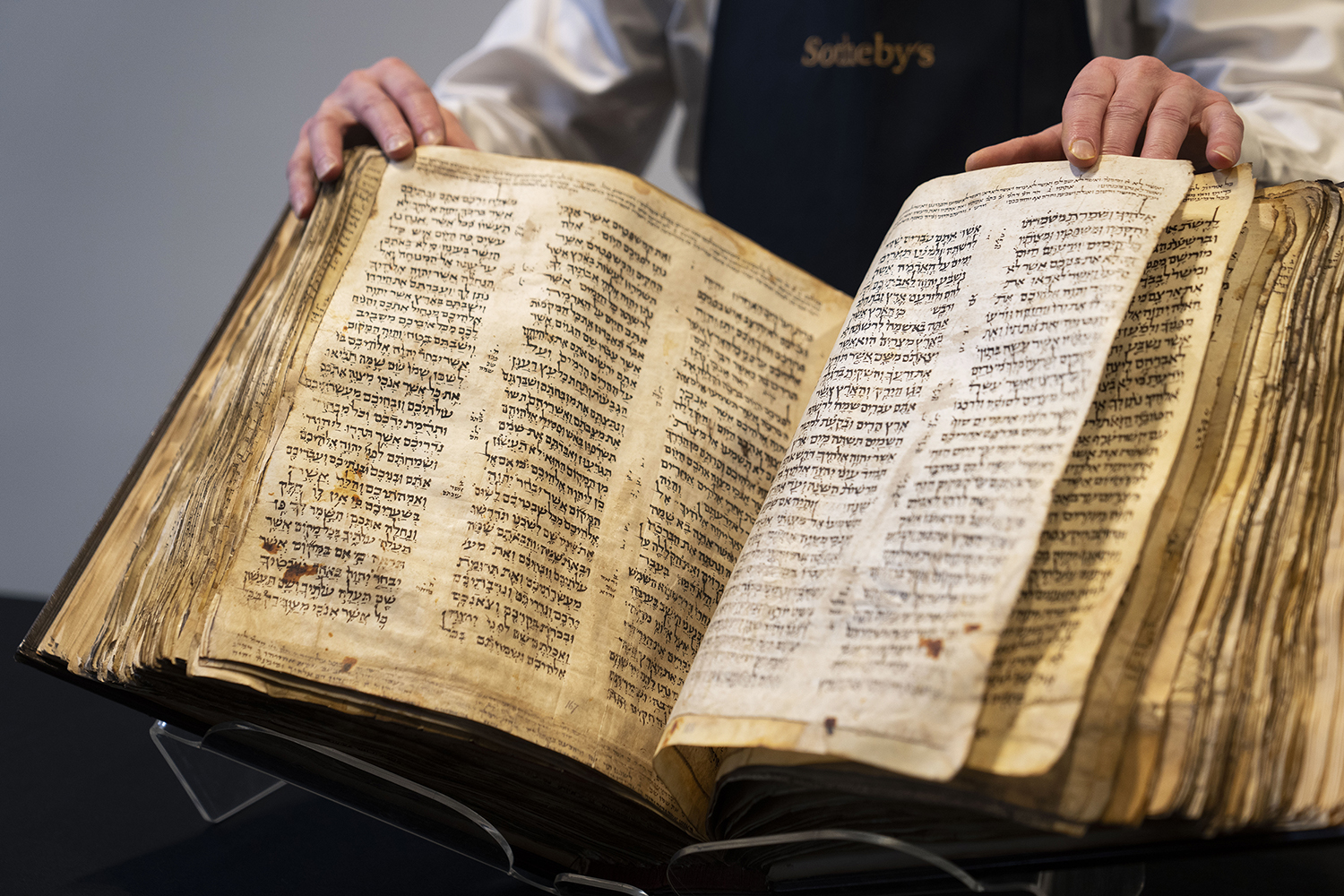
Alfred H. Moses, the former U.S. ambassador to Romania, speaks during the Geneva Summit for Human Rights and Democracy in 2017. Video screen grab
(RNS) — When an 1,100-year-old Hebrew Bible was sold at a Sotheby’s auction for a record-setting $38.1 million two weeks ago, most news articles noted few details about the person behind the purchase: Alfred H. Moses.
The former U.S. ambassador to Romania donated the amount to the American fundraising group for ANU, Museum of the Jewish People in Tel Aviv, Israel, ensuring the rare codex would be on display to the public rather than locked away as a collector’s item.
In a conversation with Religion News Service, Moses, 93, whose storied career involved being president of the American Jewish Committee and special counsel to President Carter, revealed he only learned about the codex a few months back. What drew this longtime corporate lawyer and Baltimore native to invest millions toward a Hebrew Bible he’d never seen in person?
Moses spoke to RNS about being an “observant, non-believing Jewish universalist,” his journey to becoming ambassador to Romania and how he came to fund the purchase of one of the most expensive documents ever sold at auction. This interview has been edited for length and clarity.
What was it like growing up in Baltimore in the 1930s and 1940s?
Baltimore was a segregated city. I lived in the Jewish part, and my friends were primarily Jewish. I lived in a very secure, comfortable environment. My great-grandfather started a hat factory in the 1860s, which became the largest manufacturer of men’s straw hats in the world. In my father’s lifetime it went bankrupt. My parents were reasonably prosperous until the business failed.

Alfred H. Moses during his visit to see the Codex Sassoon in person for the first time at Sotheby’s on May 31, 2023. Photo by Perry Bindelglass
We were very much part of the Jewish community in Baltimore. Religiously, we remained orthodox. We had a kosher home. I went to Seder. I became a bar mitzvah. My father did not speak Hebrew, but we read the prayers in Hebrew.
I was 12 years old when World War II broke out. We knew tons of people who were in the service. Of course as Jews, we felt particularly vulnerable because we had a sense, without knowing the details, that the Jews in Europe would be massacred by the Germans.
Is it true that years later, while president of the American Jewish Committee, you began helping thousands of Jewish people leave Romania?
I first went through Romania in 1976 as part of a delegation with the American Jewish Committee. As I was leaving my hotel, two or three young fellows came up to my wife and me and told us that life in Romania was dreadful for Jews. They were blamed for everything that went wrong. And they had to get out, can I help them? So I shook their hands and said, I’ll do what I can. I went back to the United States and I started to get Jews out of Romania. And we were quite successful. We were able to persuade Congress to grant the most favored nation status for Romania every year. In return, our request was that Jews be free to emigrate to Israel. And I worked that out with Nicolae Ceaușescu, who was then the communist dictator. I met with him in Romania on three occasions. We got the Jews out.
Then Ceaușescu was shot on Christmas Day, in 1989. I thought my work was over, but the chief rabbi requested I come back to help the community, which I did, at least once a year. And lo and behold, in 1994, the State Department asked me if I would consider being the American ambassador to Romania. I thought they were out of their minds, but they sent my nomination to the White House, and President Clinton signed it, and I became the American ambassador to Romania for three years.
When did you first hear about the Codex Sassoon?
I didn’t hear about it until about three months ago. I knew the Museum of the Jewish People in Tel Aviv. They informed me they had been selected to exhibit the Sassoon Codex in Israel. I thought, OK, let’s take a look and maybe I and some others can buy it. And the others disappeared. They weren’t interested. So I said to myself, okay, Alfred, you buy it and provide the funds for ANU to buy it. I had no idea whether I’d be successful. I thought my chances were maybe 50/50, that somebody far richer than I would swoop in and buy it. But we were lucky enough to get it, and now it’s on its way to ANU.
What made you decide to acquire the codex and donate it to the museum?
This is a very important document. It’s the oldest complete Bible, and I thought it would be a source of enormous interest and pride and education for Jews worldwide. Israel is pretty divided politically, so it’s more important than ever that we think of ourselves as part of the Jewish people worldwide. And this to me could be a magnet that would attract Jews to Israel to see it and take pride in our commonality.
I hope it will be used at ANU to bring tens of thousands or hundreds of thousands of Jews and non-Jews to view ANU in its entirety, the Museum of the Jewish People. It’s quite inspiring. And this, I think, will be the centerpiece of the museum in Tel Aviv. Scholars will have access to it. People will see it and, I think, have a renewed respect for our traditions.

Sotheby’s unveils the Codex Sassoon for auction, Wednesday, Feb. 15, 2023, in the Manhattan borough of New York. The auction house is billing the lot as the “earliest, most complete Hebrew Bible ever discovered.” (AP Photo/John Minchillo)
Can you describe the moment you saw the Codex in person?
This week was the first time I saw it. I was amazed. It’s smaller than I assumed. It’s more structurally sound. It’s all on sheep skin, and you can turn the pages. The lettering is quite legible. I can read it quite easily. It has the vowels, which is quite unusual. To think it was written over 1,000 years ago is truly amazing. And it’s a precious document. The oldest Hebrew Bible in the world now belongs to the Jewish people and is in Israel.
How did you and your family come to acquire the funds to make this donation?
For better or for worse, there’s only I. I put my family down because by giving this to ANU, it’s funds my children and grandchildren will not receive. So they’re giving it along with me. I was enormously fortunate in my life. I was a practicing lawyer of 60 years. I suppose by most standards, I was quite a successful lawyer serving clients throughout the world. I saved what money I could, I invested it, and was more than fortunate in my investments. I was blessed. I never inherited a nickel. Whatever money I have is money I made.
What does your religious or spiritual life look like today?
I describe myself as an observant, non-believing Jewish universalist. I have a Kosher home. I am Shomer Shabbat. I think God is an aspiration. I can’t get around my small brain the notion a God who created this world is sitting in judgment. But I’m very respectful of those who are observing and are also believers. I just happen not to be, but I am one who believes in the Jewish tradition. I believe in the Jewish sense of meaning, which we want to impart upon our lives, not to simply come and go. I like to think there’s a larger purpose in human beings. And it’s up to us to live up to that aspiration of the God, who, to my thinking, we’ve created. The commandment to Abraham was to do what’s right and just. And that’s still the message. And if we can do what’s right and just, that’s worthwhile. I believe in that.




